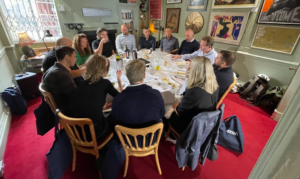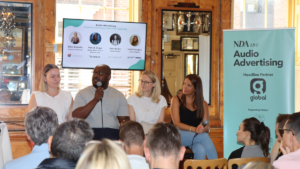With shifting sands in the ad world, including the much-vaunted cookie deprecation supposedly around the corner, marketers are looking for new ways to reach consumers and make their targeting more effective and efficient. Addressable audio ads appear to be providing the answer, but it’s not without caveats.
In the second part of our roundtable, in partnership with AMA, our panel explores why addressable audio may well resolve some previously gnarly targeting challenges. Chaired by NDA Editor, Justin Pearse, the roundtable featured Silke Zetzsche, Commercial Director UK, EMEA & ROW, AMA, Richard Williams, Commercial Director, AMA, Thomas Balaam, Business Director, Mindshare, Rhys Williams, Tech and Activation Lead, The7stars, Vlad Kamisovs, Group Director, Partnerships, Matterkind, Scott Brainff, Head of Investment, Digital & Print, Wavemaker, Sam Austin, Head of Audio, Good Stuff, Esmeralda Lockhart, UK Head of Addressable Creative, Mediacom and Blake Moseley, Global Head of Product, Addressable, Hogarth Worldwide.
When you’re looking to get personal with potential customers, it helps if the medium is already halfway there for you. “Audio is personal, it’s really hard to ignore,” states Vlad Kamisovs, Group Director, Partnerships, Matterkind. But, he adds, just because it’s already close to the consumer, you can’t abuse their eardrums. “It’s not enough to be informative, it has to have personality, something you enjoy for the content not just the product.”
While Kamisovs illustrates his point with the amusing – albeit fictional – ads that can be seen in gaming environments such as Grand Theft Auto (GTA), other panellists reveal that it’s the real time element that grabs their attention. Football was a particularly popular hook, with both Scott Braniff, Head of Investment, Digital & Print, Wavemaker and Rhys Williams, Tech and Activation Lead, The7stars, talking about how hearing specific features, live odds and live data from a tournament such as 2022’s World Cup “really resonates”.
The data issue
But with this granular content comes the need for new or better data feeds. “We’re getting more requests for API data, such as a Specsavers campaign that drew in the local appointments for optometrists in town,” states Richard Williams, Commercial Director, AMA. “Audiences are also becoming more important because audio is being driven more programmatically. The next transition will be first party data and contextuality will be really big in 2023.”
Williams believes that first-party data might struggle: “First party data can be difficult to scale and see incremental uplift. Second party – the right audience but not our customers – that will scale across 2023,” adding that at most he expects the majority of clients to target mid-funnel in a bid to steal competitor market share.
“Clients love to reach their competitors’ users. We’re being asked how we can reach the users of a certain brand, specifically,” adds Thomas Balaam, Business Director, Mindshare, and Rhys Williams, Tech and Activation Lead, The7stars. There might well be plenty of opportunities to pinch competitors’ audiences. Braniff suggests that there are many more investments in addressable audio but “there’s still a huge amount of headroom.”
The wrong creative?
How advertisers construct those ads is going to be crucial. To make the most of addressability, it’s not just a question of swapping in and out some local colour to an existing radio ad. Nor does relying purely on data targeting the right audience always deliver the best results.
Esmeralda Lockhart, UK Head of Addressable Creative, Mediacom, insists: “The audience targeting is right, but advertisers are still showing the wrong ad. We’re halfway there, let’s focus on this and make sure we’re showing the last piece of the puzzle.”
Indeed, Blake Moseley, Global Head of Product, Addressable, Hogarth Worldwide is adamant: “Creative has to be held more accountable. Based on campaign performance, 47% of it is impacted by creative. Unless you’re a really sophisticated marketer, you’ve never really looked at the impact that creative idea had on the campaign itself and held it accountable to optimise it.”
Lockhart wonders if marketers will be gently pushed towards higher quality targeted ads. “Will the death of the cookie allow us to be more creative in that respect because we rely more heavily on the audio element of actually what we’re saying to customers.”
It’s going to prove a delicate balance to tread. On the one hand, addressable audio lets you place ads where it might have proven too incongruous, despite the presence of a willing audience. “In a podcast, its overall theme might be completely off piste for the brand, but a topic within might be really relevant, that’s going to be cool in 2023,” says Sam Austin, Head of Audio, Good Stuff.
But, the message has to be relevant and, unlike its poor cousin, retargeting, has to deal with the challenge of advertisers stalking one-time browsers round the web for evermore. “If we find ourselves being creepy, that’s not creative storytelling. If we’re addressing someone there needs to be a genuine value exchange,” states Silke Zetzsche, Commercial Director UK, EMEA & ROW, AMA.












